Navratri is one of the most significant and widely celebrated festivals in India, dedicated to the worship of Goddess Durga. The festival spans nine days, during which people pray, fast, and celebrate in honor of the different forms of the Goddess. One of the most important days during Navratri is Ashtami, which falls on the eighth day of the festival. In 2024, Navratri Ashtami will be celebrated on 11th October 2024. This blog will provide you with all the details you need about Navratri Ashtami 2024, including its significance, rituals, and timings.
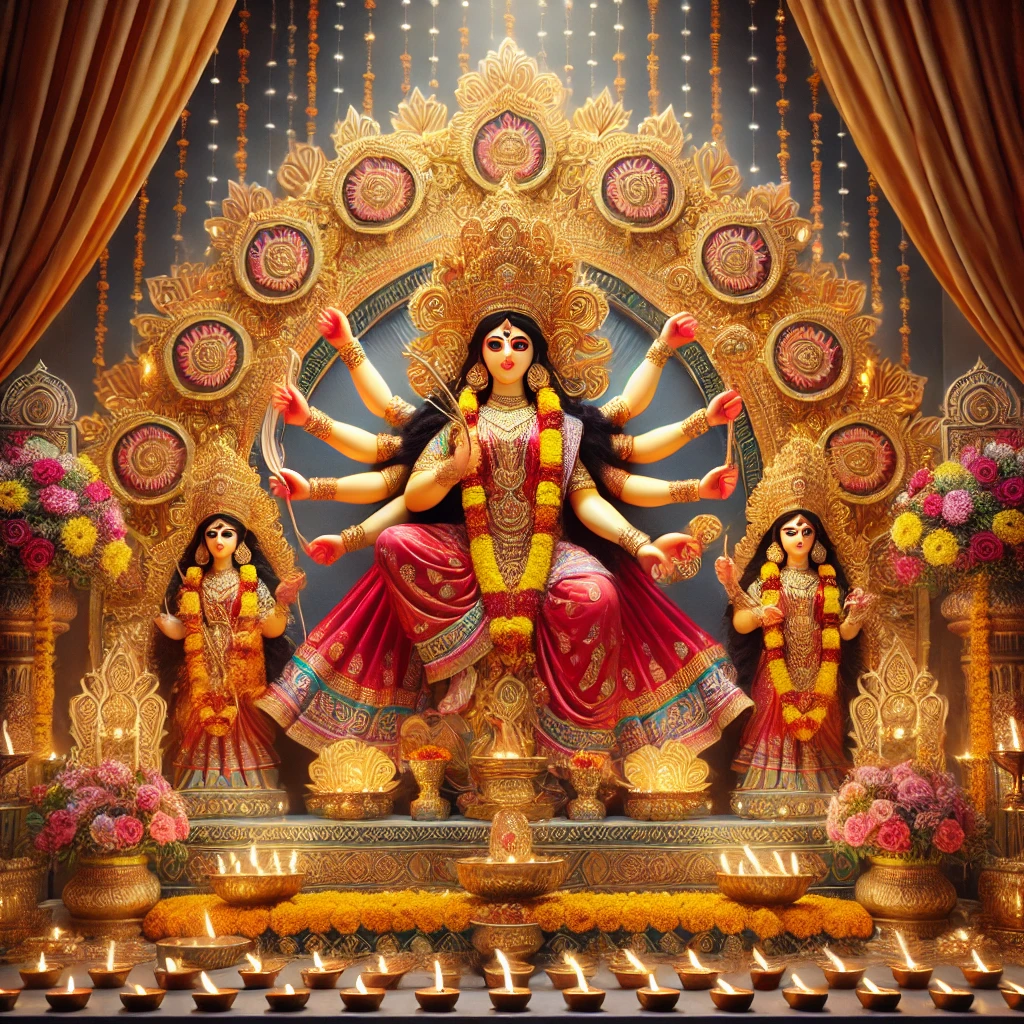
What is Navratri?
Navratri, which means “nine nights,” is a festival that honors Goddess Durga and her nine forms. Each day of Navratri is dedicated to a different avatar of the Goddess, starting from Shailaputri and ending with Siddhidatri. The festival symbolizes the triumph of good over evil and is celebrated with great enthusiasm, especially in northern, western, and eastern parts of India.
The festival usually falls in the month of September or October, depending on the Hindu calendar. Navratri culminates with Dussehra, which marks the victory of Lord Rama over Ravana, symbolizing the triumph of good over evil.
Importance of Ashtami in Navratri
Ashtami is the eighth day of Navratri and is considered one of the most significant days of the festival. This day is dedicated to Goddess Mahagauri, who symbolizes purity, serenity, and wisdom. People believe that worshipping the Goddess on this day can remove all obstacles and bring prosperity and happiness to their lives.
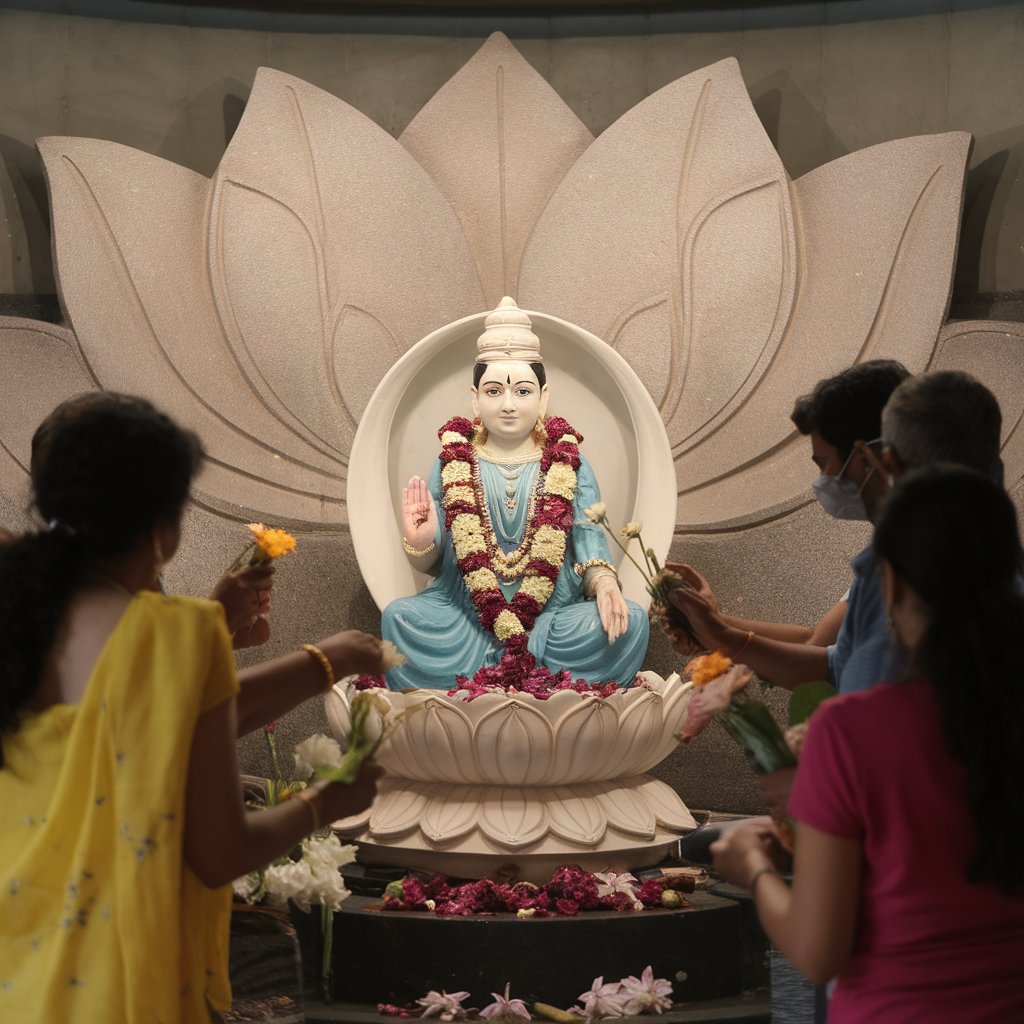
Maha Ashtami is celebrated with grand rituals and prayers. Many devotees observe a fast on this day, known as Ashtami Vrat. It is also the day when the Kanya Puja or Kanjak Puja is performed, where young girls are worshipped as embodiments of the Goddess.
Navratri Ashtami 2024 Date and Time
In 2024, Navratri Ashtami falls on 11th October. The exact Durga Ashtami 2024 date and time are important to ensure that prayers and rituals are performed at the most auspicious times. According to the Hindu calendar, the Ashtami Tithi (eighth day) will begin in the evening of 10th October 2024 and continue until 11th October 2024.
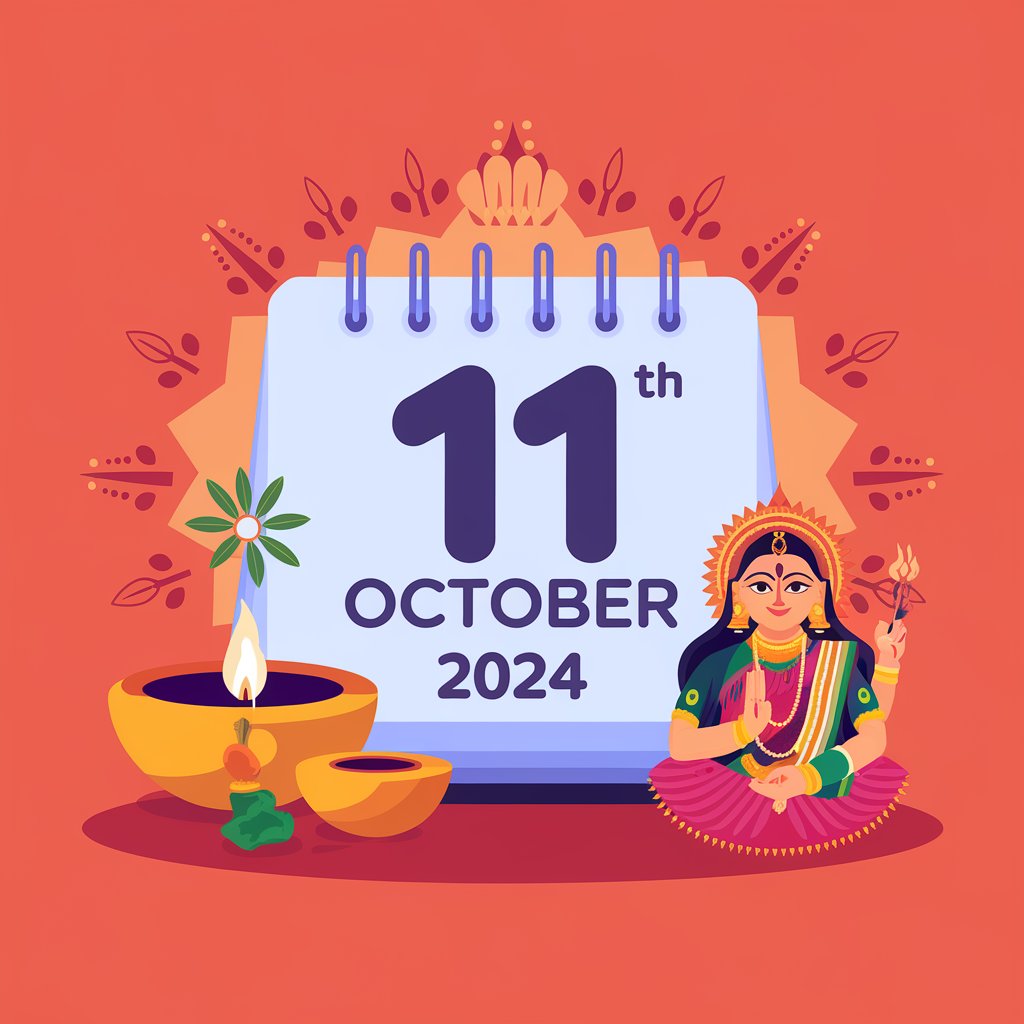
For those observing fasts or performing rituals, it’s crucial to know the right timings. Here are the important details for Ashtami 2024:
- Ashtami Tithi Start: 10th October 2024, around 12:31 PM
- Ashtami Tithi End: 11th October 2024, around 12:06 PM
This is the ideal time to perform rituals, fasts, and prayers for Navratri Ashtami 2024.
Ashtami Vrat in October 2024
Many people observe a fast on Ashtami, known as the Ashtami Vrat. This is done to seek the blessings of Goddess Durga. Fasting during Navratri, especially on Ashtami, is considered to be highly auspicious. Devotees believe that fasting on Ashtami helps to purify the mind and body and brings peace and prosperity into their lives.
While fasting, most devotees follow a strict vegetarian diet and avoid grains. They consume fruits, milk, and specific food items like buckwheat flour, water chestnut flour, and other vrat (fasting) foods. Many people also abstain from eating onion and garlic during the entire Navratri period, as these are considered tamasic (impure) foods according to Hindu traditions.
Rituals and Traditions of Durga Ashtami
The day of Durga Ashtami is filled with various rituals and traditions. Let’s take a look at the key customs associated with this day:
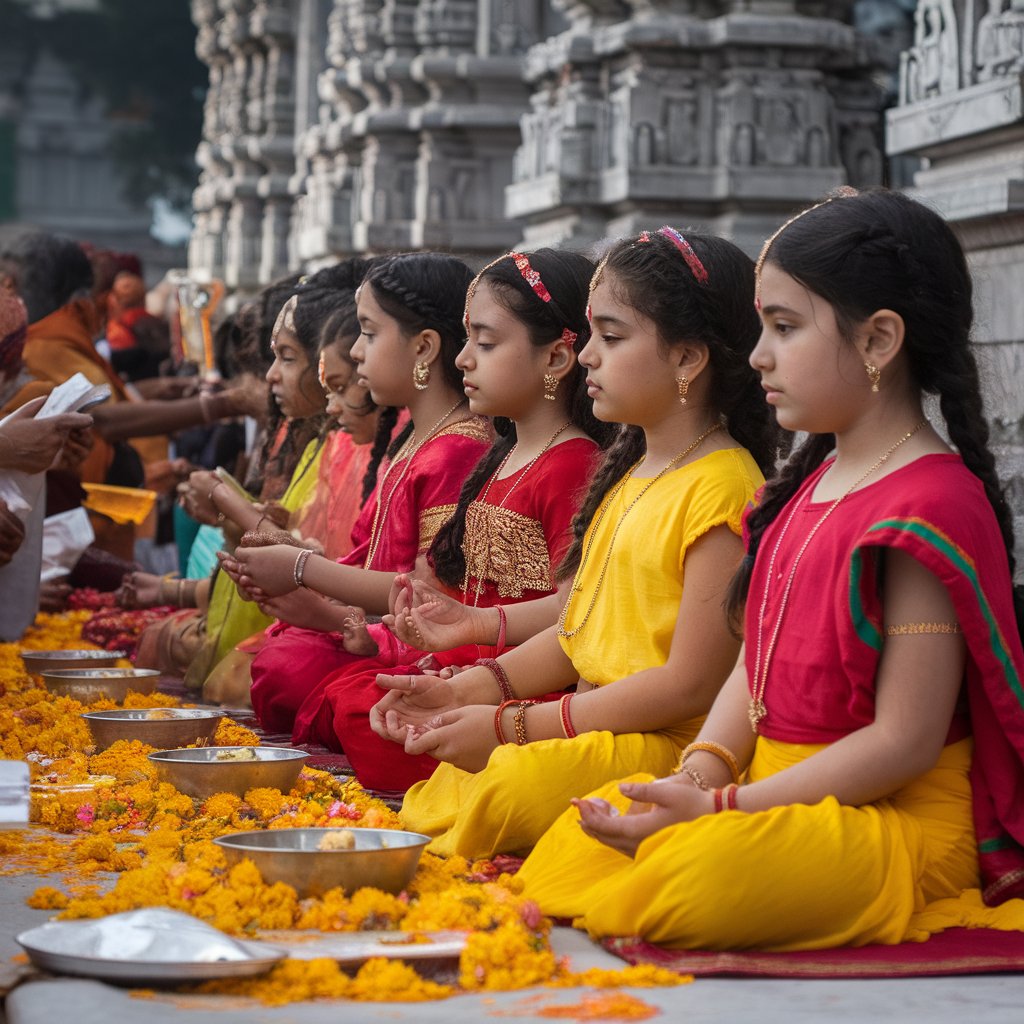
- Kanya Puja (Kanjak Puja):
One of the most important rituals of Ashtami is the worship of young girls, also known as Kanya Puja. Nine girls, representing the nine forms of Goddess Durga, are invited to devotees’ homes, where they are worshipped with flowers, sweets, and gifts. These young girls are believed to be the living incarnations of the Goddess, and honoring them is said to bring good fortune. - Sandhi Puja:
In some regions, Sandhi Puja is performed at the exact moment when Ashtami ends and Navami begins. This brief period is considered highly sacred, and devotees offer special prayers to Goddess Durga during this time. Sandhi Puja is especially popular in West Bengal, where it is one of the key highlights of the Durga Puja celebrations. - Chanting of Durga Mantras:
Devotees chant mantras dedicated to Goddess Durga during Ashtami to seek her blessings. The recitation of Durga Saptashati or Devi Mahatmyam is particularly significant, as it narrates the stories of Goddess Durga’s victories over evil forces. - Durga Puja Celebrations:
In West Bengal and other eastern states, Durga Ashtami is one of the biggest days of the Durga Puja festival. Huge idols of Goddess Durga are worshipped in beautifully decorated pandals (temporary structures), and cultural programs like dances and dramas are performed to celebrate the day. The celebrations continue into the night with prayers, songs, and dances dedicated to the Goddess.
Durga Ashtami 2024: Significance of Saptami and Navami
While Ashtami holds great importance, the seventh day (Saptami) and ninth day (Navami) of Navratri are also significant.
- Saptami: This day is dedicated to Goddess Kalaratri, who is believed to destroy all evil forces. Saptami is considered the day when the Goddess begins her battle with the demon Mahishasura. The rituals on Saptami often include the worship of weapons, symbolizing the power of Goddess Durga.
- Navami: The day after Ashtami is called Navami. In 2024, Navami will be celebrated on 12th October. Navami marks the conclusion of the main Durga Puja rituals, and it is a time when devotees thank the Goddess for her blessings. In many regions, the effigy of Mahishasura is burned, symbolizing the victory of good over evil.
Maha Ashtami 2024: Celebrations Across India
Navratri Ashtami is celebrated in different ways across various parts of India. While the core rituals remain the same, the traditions may vary from one region to another.
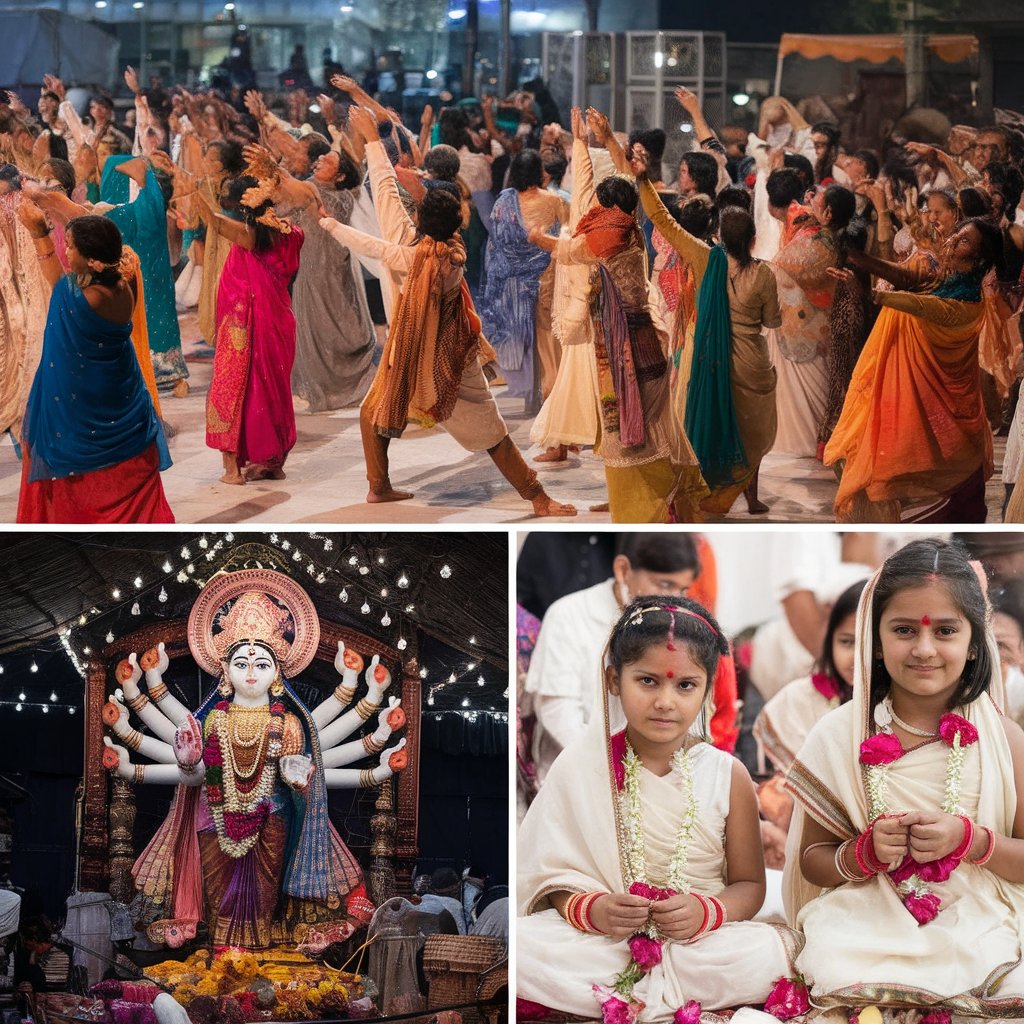
Maharashtra:
In Maharashtra, Navratri is celebrated with a blend of devotion and cultural activities. People visit temples to offer their prayers, and in some regions, Kanya Puja is performed to honor young girls. Special community events, including music and dance, are also organized.
North India:
In northern states like Uttar Pradesh, Punjab, and Haryana, devotees observe fasts and perform Kanya Puja. In many places, local fairs are held, and people gather in temples to offer their prayers. Special events like Ramlila, a dramatic reenactment of the life of Lord Rama, are also organized during this time.
West Bengal:
In West Bengal, Durga Puja is the grandest celebration of the year. Ashtami is considered one of the most important days of the festival. People visit elaborately decorated pandals, participate in cultural events, and offer prayers to large idols of Goddess Durga. The city of Kolkata is especially famous for its magnificent Durga Puja celebrations.
Gujarat:
In Gujarat, Navratri is known for the traditional dance form called Garba. On the night of Ashtami, people gather to perform Garba and Dandiya Raas, dancing to devotional songs in praise of Goddess Durga. The vibrant celebrations continue late into the night, with people dressed in colorful traditional attire.
FAQs about Navratri Ashtami 2024
Q1: What is the date of Navratri Ashtami 2024?
A1: Navratri Ashtami in 2024 will be celebrated on 11th October 2024. This day, known as Maha Ashtami, marks the eighth day of the nine-day Navratri festival.
Q2: What are the timings for Durga Ashtami 2024?
A2: The Ashtami Tithi begins on 10th October 2024, at around 12:31 PM, and ends on 11th October 2024, at around 12:06 PM. These timings are important for performing rituals and prayers on Ashtami.
Q3: What is Ashtami Vrat, and how is it observed?
A3: Ashtami Vrat is a fast observed by devotees on the eighth day of Navratri to seek blessings from Goddess Mahagauri. Fasting is believed to purify the body and mind, and those observing it usually consume specific fasting foods like fruits, milk, and certain grains like buckwheat or water chestnut flour. The fast is broken after performing the Kanya Puja (worshipping young girls) or after sunset.
Q4: What is the significance of Kanya Puja on Ashtami?
A4: Kanya Puja is one of the most important rituals of Ashtami. It involves worshipping young girls (usually nine, representing the nine forms of Goddess Durga) as incarnations of the Goddess herself. The girls are honored with flowers, food, and gifts, and the ritual is believed to bring blessings and good fortune to the devotees.
Q5: What is Sandhi Puja, and why is it performed?
A5: Sandhi Puja is a special ritual performed at the exact juncture when Ashtami ends, and Navami begins. This transition period is considered highly auspicious, and many devotees offer prayers to Goddess Durga during this time. Sandhi Puja is particularly significant in West Bengal during the Durga Puja celebrations.
Q6: What is the importance of Durga Ashtami in Navratri?
A6: Durga Ashtami is considered one of the most significant days of the Navratri festival. It is dedicated to Goddess Mahagauri, who symbolizes purity, wisdom, and peace. Devotees believe that by worshipping the Goddess on this day, they can remove obstacles and bring prosperity into their lives.
Q7: What are the differences between Saptami, Ashtami, and Navami?
A7:
- Saptami: The seventh day of Navratri, dedicated to Goddess Kalaratri, who represents power and destruction of evil.
- Ashtami: The eighth day, dedicated to Goddess Mahagauri, symbolizing purity and the removal of sins.
- Navami: The ninth day, marking the end of the Navratri rituals and often celebrated as the day of victory over evil forces. In 2024, Navami will fall on 12th October.
Q8: When is Navami 2024 during Navratri?
A8: Navami, the ninth day of Navratri, will be celebrated on 12th October 2024. This day holds special importance as it marks the conclusion of the main rituals of the festival and the preparation for Dussehra.
Q9: How is Navratri Ashtami celebrated in different regions of India?
A9:
- In North India, people observe fasts and perform Kanya Puja.
- In West Bengal, Durga Ashtami is one of the biggest days of Durga Puja, celebrated with grand rituals, processions, and cultural programs.
- In Gujarat, the night of Ashtami is marked by Garba and Dandiya Raas dance performances.
- In Maharashtra, people offer prayers in temples and participate in cultural events.
Q10: What is the connection between Durga Ashtami and Dussehra?
A10: Durga Ashtami is the eighth day of Navratri, and it leads to the celebration of Dussehra, which marks the victory of good over evil. While Ashtami is dedicated to worshipping Goddess Durga, Dussehra, celebrated after Navami, marks the triumph of Lord Rama over Ravana, symbolizing the victory of righteousness.
Q11: Why is fasting on Ashtami considered auspicious?
A11: Fasting on Ashtami is believed to purify the mind and body, helping devotees gain spiritual strength and focus. It is a way to show devotion to Goddess Durga and seek her blessings for prosperity, peace, and protection from negative forces.
Q12: What food is allowed during Ashtami Vrat?
A12: During Ashtami Vrat, devotees typically avoid grains and non-vegetarian foods. Common fasting foods include fruits, milk, and specific items made from buckwheat flour, water chestnut flour, and amaranth. Many also avoid onion, garlic, and any tamasic (impure) foods during the fast.
Q13: How is Durga Ashtami celebrated in West Bengal?
A13: In West Bengal, Durga Ashtami is a key part of the Durga Puja festival. Elaborate pandals (temporary structures) are created to house idols of Goddess Durga, and people visit these pandals to offer prayers, participate in cultural events, and enjoy festive foods. Special rituals like Sandhi Puja are also performed, and the celebration continues late into the night.
Q14: What happens after Navratri Ashtami?
A14: After Navratri Ashtami, the next significant day is Navami, followed by Dussehra. Navami marks the conclusion of the main Durga Puja rituals, while Dussehra is celebrated as the day when Lord Rama defeated Ravana, symbolizing the triumph of good over evil.
Q15: How can I perform Kanya Puja at home?
A15: To perform Kanya Puja at home, follow these steps:
- Invite nine young girls, symbolizing the nine forms of Goddess Durga.
- Wash their feet and offer them seats.
- Offer flowers, food (like halwa, puri, and chana), and gifts as a mark of respect.
- Chant prayers or Durga Mantras during the ritual.
- Seek their blessings after the puja.

